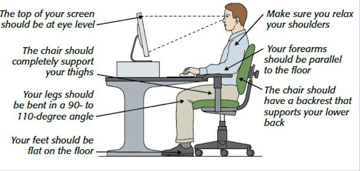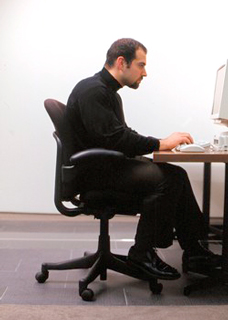Posture Perfect
Permanent link All PostsSomewhere in the world a mother is ordering a child to “Stand up straight!” Is it that easy? Can you simply stand up or sit up straight to fix your posture?
Yes, you need to be aware of your positioning if you really want to fix it. Along with exercises and stretches, you can improve your posture. The picture below details great seated posture, and you can read the accompanying article here.

Step 1: Listen to your grandmother
I slouch. It happens, and because I’m a trainer, I am lucky enough to have every single coworker point out when I slouch. I welcome that feedback. It helps me to realize I need to sit up or maybe just stand for a few minutes. If you stay in one position too long, that’s not good, especially if it’s sitting. You want to avoid rounding your shoulders and bringing your head forward. If you work at a desk like most of us do, chances are this picture happens to you:

Grandmother Guide:
- Place a mirror on your monitor to catch when you slouch
- Stand up throughout the day
- Switch your positioning
- Walk, get water, see a coworker/client
- Buddy up, have a coworker tell you when you’re slouching
A lot of people are moving toward standing desks. Standing is better than sitting, but if you’ve ever worked retail or taught, you quickly learn that standing too much can lead to an assortment of other issues. I like the sit-stand desks best, where you can vary the height of your desk throughout the day.
Step 2: Exercise
Walking is a great exercise that generally does not hurt your posture. Now this is not millennial walking, also known as “walking while texting” (WWT). If you wear dress shoes or heels to work, I recommend bringing a pair of walking shoes with you. My coworkers make fun of me because I have a few dress shoes in the office and commute to work in florescent yellow gym shoes (I shop for comfort).
There are simple exercises you can do in the office or almost anywhere to ease tension and improve your posture if you are healthy enough to exercise:
1) Belly breathe. Sit up straight, place your hands on your belly, inhale deeply though your nose, feel the air fill your diaphragm, hold for a few seconds and exhale through your mouth.
2) Shoulder rolls. With your arms at your side, lift your shoulders up, back and down, and then in the opposite direction. I usually do 20 rolls in both directions.
3) Wall press. Lean against a wall, facing away from wall, with your feet shoulder width apart, place the back of your arms against the wall and press toward the ceiling.
4) Wall clocks. I think it will be easier to watch this video.
5) Push up holds. Hold yourself in a pushup position and hold yourself up for 20 to 45 seconds without letting your head, back or hips sway. If this hurts your wrists, you can perform the exercise on your forearms.
6) Hip lifts. Lie on your back, knees bent on the ground, lift up hips and slowly lower. I do this exercise 15 to 20 times.
If you are really interested in improving your posture I recommend doing these exercises every other day. There are many other postural exercises. Pilates is a great way of strengthening your core and improving your alignment. If you have access to a class or one on one session, try it out and let me know what you think.
Step 3: Stretching
The fitness world loves to debate stretching. Some view it as a waste of time, arguing that increased flexibility leads to injury. In my opinion, it depends on the individual and the type of stretching. Below, I’ve listed a handful of stretches I like to do often. If you experience any discomfort, stop the stretch immediately.
- Hip stretch (I do not use my hand when I do this stretch)
- Door stretch. Place your arms at a 90-degree angle against a door opening, bring one foot forward and lean toward that foot.
- Hamstring doorway stretch
- Calf Stretch
Do you have a favorite adjustable desk, exercise or stretch? Send it my way, and don’t forget to stand/sit up straight!



.jpg)



